
Scanning a library of 27 million different molecules, a bi-institutional team identified some that work more effectively than the existing pain medications gabapentin and pregabalin.
Prescribed to nearly 50 million Americans in 2020, gabapentin is used to treat pain and dysfunction related to restless leg syndrome, epilepsy, hot flashes, and neuropathy or nerve pain, while pregabalin is prescribed to nearly 10 million Americans, but has even harsher side effects that can lead to death.
Calcium channels play a central role in pain signaling, in part through the release of neurotransmitters such as glutamate and GABA—“the currency of the pain signal,” according to Rajesh Khanna, director of the NYU Pain Research Center.
The newly identified molecule binds to an inner region of a calcium channel to indirectly regulate it, outperforming gabapentin without troublesome side effects and providing a promising candidate for treating pain.
“Developing effective pain management with minimal side effects is crucial, but creating new therapies has been challenging,” said Khanna, the senior author of the PNAS study which recorded his discovery. “Rather than directly going after known targets for pain relief, our lab is focused on indirectly targeting proteins that are involved in pain.”
In particular, this research centered around a protein called CRMP2, a key regulator of the calcium channel and which binds to it from the inside. He and his colleagues previously discovered a peptide (a small region of amino acids) derived from CRMP2 that could uncouple CRMP2 from the calcium channel.
When this peptide—dubbed the calcium channel‐binding domain 3, or CBD3 (not to be confused with a cannabidiol)—was delivered to cells, it acted as a decoy, blocking CRMP2 from binding to the inside of the calcium channel.
This resulted in less calcium entering the calcium channel and less neurotransmitter release, which translated to less pain in animal studies.
NEW DRUG DISCOVERIES: African Psychedelic Plant Medicine Inspires Two New Drugs to Treat Addiction and Depression
Peptides are difficult to synthesize as drugs because they are short-acting and easily degrade in the stomach, so the researchers sought to create a small molecule drug based on CBD3.
Starting with the 15 amino acids that make up the CBD3 peptide, they honed in on two amino acids that studies showed were responsible for inhibiting calcium influx and mitigating pain.
“At that point, we realized that these two amino acids could be the building blocks for designing a small molecule,” Khanna told NYU press.
In collaboration with colleagues at the University of Pittsburgh, the researchers ran a computer simulation that screened a library of 27 million compounds to look for a small molecule that would “match” the CBD3 amino acids.
The simulation narrowed the library down to 77 compounds, which the researchers experimentally tested to see if they lessened the amount of calcium influx. One compound, which the researchers named CBD3063, emerged as the most promising candidate for treating pain.
MORE NEWS LIKE THIS: UPDATE—World’s First Drug to Regrow Teeth Enters Clinical Trials
Khanna’s lab then tested CBD3063 with mouse models for pain related to injury. The compound was effective in alleviating pain in both male and female mice. Notably, in a head-to-head test with the drug gabapentin, the researchers needed to use far less CBD3063 (1 to 10 mg) than gabapentin (30 mg) to reduce pain.
To explore whether CBD3063 helped with different types of chronic pain, Khanna partnered with researchers at Virginia Commonwealth University, Michigan State University, and Rutgers University. Collaborators ran similar studies administering CBD3063 to treat animal models of chemotherapy-induced neuropathy, inflammatory pain, and trigeminal nerve pain—all successfully reversing pain, similar to gabapentin.
But unlike gabapentin, the use of CBD3063 did not come with side effects, including sedation, changes to cognition such as memory and learning, or changes to heart rate and breathing.
GOOD PHARMA NEWS: Life-Saving Overdose Drug Narcan Approved by FDA for Over-the-Counter and Online Sale
In the long term, they hope to bring a CBD3063-derived drug to clinical trials in an effort to offer new options for safe and effective pain relief.
“Identifying this first-in-class small molecule has been the culmination of more than 15 years of research. Though our research journey continues, we aspire to present a superior successor to gabapentin for the effective management of chronic pain,” said Khanna.
SHARE This Researcher’s Success In Seeking Safer, More Effective Drugs…




















